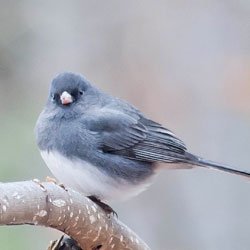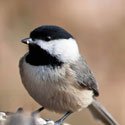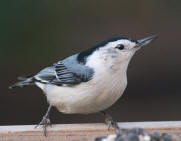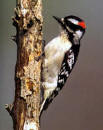Common Birds: Black and White or Gray and White Birds
 Dark-eyed Junco: 5 1/2 to 6 3/4 " in size. Juncos are small, dark gray birds with white bellies. Juncos look different in different regions of the United States. In the East, Juncos are dark gray with white underparts and white outer tail feathers. Males are darker gray than females, which tend to be more brown. Juncos in the west have black hoods with reddish-brown backs and sides, the females are drabber. In the Black Hills of South Dakota and Wyoming, Juncos are blue-gray above and white below, with two white wing bars. In the Southern Rockies, they are pale gray, with slightly darker heads and reddish-brown backs.
Dark-eyed Junco: 5 1/2 to 6 3/4 " in size. Juncos are small, dark gray birds with white bellies. Juncos look different in different regions of the United States. In the East, Juncos are dark gray with white underparts and white outer tail feathers. Males are darker gray than females, which tend to be more brown. Juncos in the west have black hoods with reddish-brown backs and sides, the females are drabber. In the Black Hills of South Dakota and Wyoming, Juncos are blue-gray above and white below, with two white wing bars. In the Southern Rockies, they are pale gray, with slightly darker heads and reddish-brown backs.
Food: Juncos eat weed seeds and berries. At feeders, they eat millet, cracked corn, and sunflower seeds.
Range: In the winter, Juncos can be found in most of the United States. They breed in the western United States, the Appalachians, the northern Mid-West and New England.
A common nickname for Juncos in Snowbirds because they arrive in the winter, seeming to bring snowy weather with them.
The above video shows a Junco perched on a branch on a snowy day.
More info: Dark-eyed Junco at the Cornell Lab of Ornithology.

Chickadee: 4 3/4 to 5 3/4 " in size. The two common varieties of Chickadee are the Black Capped Chickadee and the Carolina Chickadee. They are almost identical in appearance. Both are small birds with black caps, black bibs, and white cheek patches. The male and female look alike.
Food: Chickadees eat insects and seeds. At the feeder, the Chickadee's favorite food is sunflower seeds.
Range: Black-capped Chickadees are permanent residents of the northern half of the United States and Canada. Carolina Chickadees are permanent residents in the South.
More info: Black capped Chickadee at Cornell Lab of Ornithology.
White-breasted Nuthatch: 5 to 6" in size. White-breasted Nuthatches are small, gray birds with black heads and white underparts. Nuthatches are often seen walking head first down the side of trees.

Food: Nuthatches eat insects and seeds. At feeders, they prefer sunflower seed, peanuts, and suet.
Range: White-breasted nuthatches are permanent residents throughout most of the United States.
More info: White Breasted Nuthatch at Cornell Lab of Ornithology.
The video below shows a Nuthatch feeding in its usual head-first upside down manner.

Downy Woodpecker: 6 1/2 to 6 3/4 " in size. The Downy Woodpecker is mostly black and white. It has a white back, black wings with white spots, black head, and a white eye stripe. The male has a red patch on the back of his head, the female does not.
Food: Downy Woodpeckers eat insects. At feeders, they like suet, and will sometimes eat sunflower seeds. Downy Woodpeckers are more common at feeders than other woodpeckers.
Range: Downey Woodpeckers are found in every state except Hawaii.
More info: Downy Woodpecker at the Patuxent Bird Identification InfoCenter.
Downy Woodpecker or Hairy Woodpecker? Downy Woodpeckers are more commonly seen at backyard feeders, but Hairy Woodpeckers do show up at feeders now and then. Downy and Hairy Woodpeckers are very similar in appearance. The main difference is their size, but that can be difficult to determine when looking at a bird from a distance. The video below shows side by side comparision of a Downy and Hairy Woodpecker. Watch through to the split screen portion to see to two different woodpeckers side by side.
